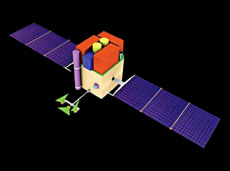

Madhavan Nair
Chairman, Indian Space Research Organization (ISRO)
Graduated in Engineering from Kerala University in 1966, Mr. Nair is known for numerous contributions to the development of the first Indian Satellite Launch Vehicle SLV-3. As the Director of the Liquid Propulsion Systems Centre in 1995-99, he contributed to the development of India's first Geo-synchronous Satellite Launch Vehicle (GSLV). Since then, he has held various positions such as Director of the Vikram Sarabhai Space Centre in Trivandrum, India's core of rocket development, before assuming his present position in 2003.

Moon Explorer Chandorayaan-1 (courtesy of ISRO)

PSLV Launch Vehicle (courtesy of ISRO)

Astronomy Satellite ASTROSAT (courtesy of ISRO)
One of our principal roles is to provide national services, such as earth observation using remote sensing technologies, as well as communications and disaster management. Sentinel Asia is a project that uses space technologies and earth observation satellites for disaster management in the Asia Pacific region, and I think it is a very good project, both in terms of national service because India is prone to natural disasters, and in terms of making contributions to the Asia Pacific region. We are cooperating with Japan on this project.
At the same time we are looking at the scientific exploration of outer space. We have been conducting experiments by piggybacking on other countries' space missions, but soon we will have our own dedicated science missions.
Chandrayaan, India's mission to the moon, is one such example. We are putting the best of Indian technology into this satellite, and we are executing everything from the construction of the satellite to its launch on our own. We will have a host of sensors from the Indian scientific community as well as a few sensors from America and Europe, which will form the basis for this experiment. This satellite will be launched with our PSLV launch vehicle, and inserted into an orbit of around 100 kilometers around the moon. It will collect geological data, and do a mineralogical analysis of the lunar surface. We expect this mission to last for about two years.
In addition, we are preparing to launch India's first astronomy satellite, ASTROSAT, in 2008. It will have detectors in the infrared, visible, ultraviolet, X-ray and gamma bands, so astronomers will be able to observe the stars, galaxies, black holes, etc. using the various sensors simultaneously. This will offer good opportunities for astronomers around the world to look at the planets and the galaxy and the universe at large. For this project, we have an agreement for international cooperation with Japan in the field of X-ray astronomy. So such science missions are encouraging.
Q. What are India's plans in the field of manned space exploration?
In the few years, we have been strongly debating whether or not we should embark on a manned mission. There's a strong view from the scientific community that there are many experiments and observations that can be done only with the presence of man in space. But at the same time, the technology challenges associated with developing manned missions are very high, and also the cost is very high. So we are in the process of evaluating what technologies need to be developed to send a manned mission to space, and whether we can do it within a reasonable timeframe and cost. Based on these evaluations, we hope to submit a report to the government within a year. And if the government approves, we'll embark on manned programs in the coming years.